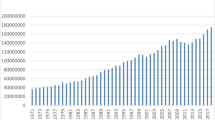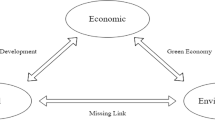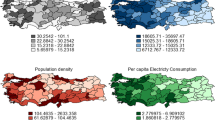Abstract
This paper investigates the relationship between income inequality and environmental degradation for the case of Turkey between 1987 and 2017 through the bootstrap causality method that changes over time. The study used the GINI coefficient to denote income inequality and ecological footprint (EFP) to represent environmental degradation. According to the analysis results, a causal relationship has been determined for Turkey from GINI to EFP between 2002 and 2015 and from EFP to GINI between 2002 and 2008. Thanks to the method used in the analysis, it was concluded that GINI-affected EFP positively between 2002 and 2005 and negatively between 2006 and 2015. Between 2002 and 2005, Turkey endured a difficult period of restructuring after two major banking crises in 1999 and 2001. The rapid development, especially in industry and urbanization, caused environmental degradation in this period. Between 2006 and 2015, the central dynamic of Turkey's growth trend was the finance sector, and rapid privatizations were realized. Nevertheless, the income justice improvement in this period negatively impacted the environment due to consumption and production habits. Policymakers should evaluate Turkey in its economic reality and produce policies accordingly. Environmental awareness should be increased in the production and consumption activities of all segments of society, benefiting from the developments in income distribution. The ecological impact of the income redistribution policy, along with its market and social consequences, needs to be evaluated.





Similar content being viewed by others
Data availability
All of the data used in the study were collected from publicly available data from the websites of the institutions listed below.
* Global Footprint Network (https://www.footprintnetwork.org).
* The Standardized World Income Inequality Database (https://fsolt.org).
References
Ak MZ, Kirca M, Altintas N (2016) The impacts of financial development on growth: a time-varying causality analysis for Turkey*/Utjecaj financijskog razvoja na rast: analiza vremenske kauzalnosti za Tursku. Zbornik Radova Ekonomski Fakultet u Rijeka 34(2):529
Ali A, Audi M (2016) The impact of income inequality, environmental degradation and globalization on life expectancy in Pakistan: an empirical analysis
Alvarado R, Toledo E (2017) Environmental degradation and economic growth: evidence for a developing country. Environ Dev Sustain 19(4):1205–1218
Arslanturk Y, Balcilar M, Ozdemir ZA (2011) Time-varying linkages between tourism receipts and economic growth in a small open economy. Econ Model 28(1–2):664–671
Baek J, Gweisah G (2013) Does income inequality harm the environment?: Empirical evidence from the United States. Energy Policy 62:1434–1437
Balcilar M, Ozdemir ZA, Arslanturk Y (2010) Economic growth and energy consumption causal nexus viewed through a bootstrap rolling window. Energy Economics 32(6):1398–1410
Baloch A, Shah SZ, Noor ZM, Magsi HB (2018) The nexus between income inequality, economic growth and environmental degradation in Pakistan. GeoJournal 83(2):207–222
Boyce JK (1994) Inequality as a cause of environmental degradation. Ecol Econ 11(3):169–178
Boyce JK, Klemer AR, Templet PH, Willis CE (1999) Power distribution, the environment, and public health: a state-level analysis. Ecol Econ 29(1):127–140
Brooks C, Hinich MJ (1998) Episodic nonstationarity in exchange rates. Appl Econ Lett 5(11):719–722
Ehigiamusoe KU, Majeed MT, Dogan E (2022) The nexus between poverty, inequality and environmental pollution: evidence across different income groups of countries. J Clean Prod 341:130863
Ekeocha DO (2021) Urbanization, inequality, economic development and ecological footprint: Searching for turning points and regional homogeneity in Africa. J Clean Prod 291:125244
Ekins P (1997) The Kuznets curve for the environment and economic growth: examining the evidence. Environ Plan A 29(5):805–830
Erdoğan S, Gedikli A, Kırca M (2019) A note on time-varying causality between natural gas consumption and economic growth in Turkey. Resour Policy 64:101504
Golley J, Meng X (2012) Income inequality and carbon dioxide emissions: the case of Chinese urban households. Energy Economics 34(6):1864–1872
Grunewald N, Klasen S, Martínez-Zarzoso I, Muris C (2017) The trade-off between income inequality and carbon dioxide emissions. Ecol Econ 142:249–256
Gülmez A, Altıntaş N, Kahraman ÜO (2020) A puzzle over ecological footprint, energy consumption and economic growth: the case of Turkey. Environ Ecol Stat. https://doi.org/10.1007/s10651-020-00465-1
Guo L (2017) Income inequality, household consumption and CO2 emissions in China. Singapore Econ Rev 62(02):531–553
Hacker RS, Hatemi-J A (2006) Tests for causality between integrated variables using asymptotic and bootstrap distributions: theory and application. Appl Econ 38(13):1489–1500
Hailemariam A, Dzhumashev R, Shahbaz M (2019) Carbon emissions, income inequality and economic development. Empirical Economics 1–21
Hao Y, Chen H, Zhang Q (2016) Will income inequality affect environmental quality? Analysis based on China’s provincial panel data. Ecol Ind 67:533–542
Heerink N, Mulatu A, Bulte E (2001) Income inequality and the environment: aggregation bias in environmental Kuznets curves. Ecol Econ 38(3):359–367
Idrees M, Majeed MT (2022) Income inequality, financial development, and ecological footprint: fresh evidence from an asymmetric analysis. Environ Sci Pollut Res 29(19):27924–27938
Islam SN (2015) Inequality and environmental sustainability.
Jammazi R, Ferrer R, Jareño F, Shahzad SJH (2017) Time-varying causality between crude oil and stock markets: what can we learn from a multiscale perspective? Int Rev Econ Financ 49:453–483
Jorgenson A, Schor J, Huang X (2017) Income inequality and carbon emissions in the United States: a state-level analysis, 1997–2012. Ecol Econ 134:40–48
Kanda P, Burke M, Gupta R (2018) Time-varying causality between equity and currency returns in the United Kingdom: evidence from over two centuries of data. Physica A 506:1060–1080
Kasuga H, Takaya M (2017) Does inequality affect environmental quality? Evidence from major Japanese cities. J Clean Prod 142:3689–3701
Kazemzadeh E, Fuinhas JA, Koengkan M (2022) The impact of income inequality and economic complexity on ecological footprint: an analysis covering a long-time span. J Environ Econ Policy 11(2):133–153
Khan S, Yahong W (2022) Income inequality, ecological footprint, and carbon dioxide emissions in Asian developing economies: what effects what and how? Environ Sci Pollut Res 29(17):24660–24671
Khan S, Yahong W, Zeeshan A (2022) Impact of poverty and income inequality on the ecological footprint in Asian developing economies: assessment of sustainable development goals. Energy Rep 8:670–679
Langnel Z, Amegavi GB, Donkor P, Mensah JK (2021) Income inequality, human capital, natural resource abundance, and ecological footprint in ECOWAS member countries. Resour Policy 74:102255
Masud MM, Kari FB, Banna H, Saifullah MK (2018) Does income inequality affect environmental sustainability? Evidence from the ASEAN-5. J Asia Pac Econ 23(2):213–228
Munasinghe M (1999) Is environmental degradation an inevitable consequence of economic growth: tunneling through the environmental Kuznets curve. Ecol Econ 29(1):89–109
Narayan PK, Saboori B, Soleymani A (2016) Economic growth and carbon emissions. Econ Model 53:388–397
Nasreen S, Riaz MF (2016) Relationship between corruption, income inequality and environmental degradation in Pakistan: an econometric analysis. Bull Energy Econ (BEE) 4(1):12–22
Ozcan B, Tzeremes PG, Tzeremes NG (2020) Energy consumption, economic growth and environmental degradation in OECD countries. Econ Model 84:203–213
Pata UK, Yilanci V, Hussain B, Naqvi SAA (2022) Analyzing the role of income inequality and political stability in environmental degradation: evidence from South Asia. Gondwana Res 107:13–29
Perron P (1989) The great crash, the oil price shock, and the unit root hypothesis. Econometrica 1361–1401
Ravallion M, Heil M, Jalan J (2000) Carbon emissions and income inequality. Oxf Econ Pap 52(4):651–669
Sager L (2019) Income inequality and carbon consumption: evidence from Environmental Engel curves. Energy Econ 104507
Said SE, Dickey DA (1984) Testing for unit roots in autoregressive-moving average models of unknown order. Biometrika 71(3):599–607
Solt F (2020) Measuring income inequality across countries and over time: the standardized world income inequality database. Soc Sci Q 101(3):1183–1199
Stern DI, Common MS, Barbier EB (1996) Economic growth and environmental degradation: the environmental Kuznets curve and sustainable development. World Dev 24(7):1151–1160
Tang CF (2008) Wagner’s law versus Keynesian hypothesis: new evidence from recursive regression-based causality approaches. IUP J Public Financ 6(4):29–38
Toda HY, Yamamoto T (1995) Statistical inference in vector autoregressions with possibly integrated processes. J Econ 66(1–2):225–250
Torras M, Boyce JK (1998) Income, inequality, and pollution: a reassessment of the environmental Kuznets curve. Ecol Econ 25(2):147–160
Uzar U, Eyuboglu K (2019) The nexus between income inequality and CO2 emissions in Turkey. J Clean Prod 227:149–157
Wackernagel M, Rees W (1998) Our ecological footprint: reducing human impact on the earth (Vol. 9). New society publishers
Wolde-Rufael Y, Idowu S (2017) Income distribution and CO2 emission: a comparative analysis for China and India. Renew Sustain Energy Rev 74:1336–1345
Yilanci V, Bozoklu Ş (2014) Price and trade volume relationship in Turkish stock market: a time-varying asymmetric causality analysis. Ege Academic Review 14(2):211–220
Yilanci V, Kilci EN (2021) The role of economic policy uncertainty and geopolitical risk in predicting prices of precious metals: evidence from a time-varying bootstrap causality test. Resour Policy 72:102039
Zeren F, Koç M (2016) Time varying causality between stock market and exchange rate: evidence from Turkey, Japan and England. Econ Res-Ekonomska Istraživanja 29(1):696–705
Zhang XP, Cheng XM (2009) Energy consumption, carbon emissions, and economic growth in China. Ecol Econ 68(10):2706–2712
Zhang C, Zhao W (2014) Panel estimation for income inequality and CO2 emissions: a regional analysis in China. Appl Energy 136:382–392
Author information
Authors and Affiliations
Contributions
Nurullah Altıntaş: supervision and conceptualization. Mustafa Kırca: data curation and methodology writing—original draft. Samet Acar: writing—reviewing and editing. Abdullah Aydın: investigation. Musa Öztürk: writing—original draft.
Corresponding author
Ethics declarations
Consent to participate
Not applicable.
Consent for publication
Not applicable.
Competing interests
The authors declare no competing interests.
Additional information
Reponsible editor: Eyup Dogan
Publisher's note
Springer Nature remains neutral with regard to jurisdictional claims in published maps and institutional affiliations.
Rights and permissions
Springer Nature or its licensor holds exclusive rights to this article under a publishing agreement with the author(s) or other rightsholder(s); author self-archiving of the accepted manuscript version of this article is solely governed by the terms of such publishing agreement and applicable law.
About this article
Cite this article
Altıntaş, N., Kırca, M., Acar, S. et al. Time-varying causality between income inequality and ecological footprint in Turkey. Environ Sci Pollut Res 30, 11785–11797 (2023). https://doi.org/10.1007/s11356-022-22910-3
Received:
Accepted:
Published:
Issue Date:
DOI: https://doi.org/10.1007/s11356-022-22910-3




